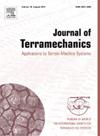混合灰狼优化-人工神经网络预测越野车车轮能耗并加强资源管理
IF 3.7
3区 工程技术
Q3 ENGINEERING, ENVIRONMENTAL
引用次数: 0
摘要
本研究采用混合人工神经网络(ANN)和灰狼优化算法(GWO)对越野车辆的车轮能耗进行预测。主要目的是改善资源管理,减少因车轮-土壤相互作用而消耗的能量。实验数据通过Bevameter装置在受控环境中收集。将侵彻深度、侵彻速度、垂直载荷、板材尺寸和孔道数等关键参数作为神经网络的输入。使用两种试错法和GWO算法对神经网络进行训练,并使用MSE和R2指标对其性能进行评估。结果表明,GWO法比试错法具有较低的均方误差0.5123和较高的确定系数0.9812。数据分析表明,增加速度和竖向荷载会导致能耗增加,而增加土压实次数则会降低能耗。研究表明,结合GWO算法的混合神经网络可以有效地预测土壤中板压痕的能量消耗,这是车轮的一种代表。本文章由计算机程序翻译,如有差异,请以英文原文为准。
Hybrid grey wolf optimizer-ANN for predicting wheel energy consumption in off-road vehicles and enhancing resource management
This study uses a hybrid artificial neural network (ANN) with the Gray Wolf optimization algorithm (GWO) to predict wheel energy consumption in off-road vehicles. The main objective is to improve resource management and reduce the energy consumed due to wheel-soil interaction. Experimental data were collected through a Bevameter device in a controlled environment. Key parameters such as penetration depth, penetration velocity, vertical load, plate size, and number of passes were considered as inputs to the neural network. The neural network was trained using two trial-and-error methods and the GWO algorithm, and its performance was evaluated using MSE and R2 metrics. The results showed that the GWO method performed better than the trial-and-error method, with a lower MSE of 0.5123 and a higher coefficient of determination of 0.9812. Data analysis showed that increasing speed and vertical load led to increased energy consumption while increasing the number of passes due to soil compaction reduced the energy consumption. This study shows that a hybrid neural network with the GWO algorithm can effectively predict the energy consumption in the indentation of plates in the soil, which is a kind of representative of the wheel.
求助全文
通过发布文献求助,成功后即可免费获取论文全文。
去求助
来源期刊

Journal of Terramechanics
工程技术-工程:环境
CiteScore
5.90
自引率
8.30%
发文量
33
审稿时长
15.3 weeks
期刊介绍:
The Journal of Terramechanics is primarily devoted to scientific articles concerned with research, design, and equipment utilization in the field of terramechanics.
The Journal of Terramechanics is the leading international journal serving the multidisciplinary global off-road vehicle and soil working machinery industries, and related user community, governmental agencies and universities.
The Journal of Terramechanics provides a forum for those involved in research, development, design, innovation, testing, application and utilization of off-road vehicles and soil working machinery, and their sub-systems and components. The Journal presents a cross-section of technical papers, reviews, comments and discussions, and serves as a medium for recording recent progress in the field.
 求助内容:
求助内容: 应助结果提醒方式:
应助结果提醒方式:


